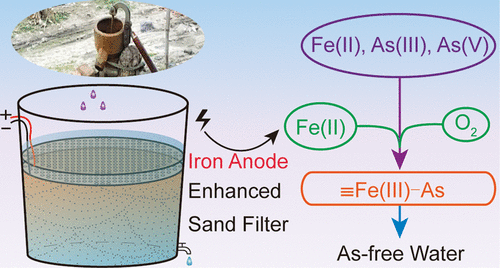
Sand filters are widely used for well water purification in endemic arsenicosis areas, but arsenic (As) removal is difficult at low intrinsic iron concentrations. This work developed an enhanced sand filter by electrochemically generated Fe(II) from an iron anode. The efficiency of As removal was tested in an arsenic burdened region in the Jianghan Plain, central China. By controlling a current of 0.6 A and a flow rate of about 12 L/h, the filter removed total As in the tube well water from 196 to 472 μg/L to below 10 μg/L, whereas the residual As was about 110 μg/L without electricity. Adsorption and subsequent oxidation on the surface of Fe(III) precipitates are the main processes controlling the removals of As and Fe. During a 30-day intermittent operation, both effluent As concentration and electrical energy consumption decreased progressively. Although filter clogging was observed, it can be alleviated by replacing the top layer of sand. Our findings suggest that dosing Fe(II) by an iron anode is an effective means to enhance As removal in a sand filter. 全文链接




